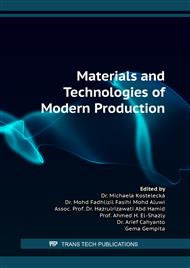[1]
W. S. Askew and R. B. Beckmann, Heat and mass transfer in an agitated vessel, Industrial & Engineering Chemistry Process Design and Development. 4(3) (1965) 311-318.
DOI: 10.1021/i260015a016
Google Scholar
[2]
L. Broniarz-Press and S. Rozanska, Determination of the flow and heat transfer characteristics in non-Newtonian media agitated using the electrochemical technique, International journal of heat and mass transfer. 51(3-4) (2008) 910-919.
DOI: 10.1016/j.ijheatmasstransfer.2007.11.003
Google Scholar
[3]
M. Cudak and J. Karcz, Distribution of local heat transfer coefficient values in the wall region of an agitated vessel, Chemical Papers. 62(1) (2008) 92-99.
DOI: 10.2478/s11696-007-0084-6
Google Scholar
[4]
A. Le Lan and H. Angelino, Study of the analogy between heat and mass transfer to the wall of a stirred tank, International Journal of Heat and Mass Transfer. 18(1) (1975) 163-167.
DOI: 10.1016/0017-9310(75)90019-8
Google Scholar
[5]
T. Mizushina, R. Ito, S. Hiraoka, A. Ibusuki, and I. Sakaguchi, Transport phenomena at the wall of agitated vessels, Journal of Chemical Engineering of Japan. 2(1) (1969) 89-94.
DOI: 10.1252/jcej.2.89
Google Scholar
[6]
P. R. Roberge, Corrosion engineering, McGraw-Hill Education, New York, (2008).
Google Scholar
[7]
R. K. E. Albers, M. J. J. Houterman, T. Vergunst, E. Grolman, and J. A. Moulijn, Novel monolithic stirred reactor, AIChE Journal. 44(11) (1998) 2459-2464.
DOI: 10.1002/aic.690441113
Google Scholar
[8]
A. S. Fathalla, N. K. Amin, E.-S. Z. El-Ashtoukhy, and G. H. Sedahmed, Mass and heat transfer intensification at the wall of a square agitated vessel by chemically active semicylindrical turbulence promoters, Alexandria Engineering Journal. 60(5) (2021) 4775-4786.
DOI: 10.1016/j.aej.2021.03.066
Google Scholar
[9]
F. Shokry, M. Abd Elfattah, D. A. El-Gayar, H. A. Farag, and G. H. Sedahmed, Effect of drag reducing polymers and impeller geometry on the rate of mass and heat transfer at the wall of a cylindrical stirred tank reactor in relation to catalytic reactor design, Alexandria Engineering Journal. 59(1) (2020) 509-518.
DOI: 10.1016/j.aej.2020.01.025
Google Scholar
[10]
M. M. Taha, Y. O. Fouad, M. H. Abdel-Aziz, A. H. Konsowa, and G. H. Sedahmed, Mass and heat transfer behaviour of catalytic and electrochemical stirred tank reactors employing metallic screens lining as a reaction surface, The Canadian Journal of Chemical Engineering. 94(8) (2016) 1539-1547.
DOI: 10.1002/cjce.22515
Google Scholar
[11]
M. A. El-Naggar, M. S. Mansour, A. H. El-Shazly, S. A. Nosier, Y. A. El-Taweel, and G. H. Sedahmed, Intensification of the Rate of Diffusion-controlled Electrochemical and Catalytic Reactions at a Helical Coil by a Fixed Bed Turbulence Promoter, Chemical and Biochemical Engineering Quarterly. 32(3) (2018) 307-313.
DOI: 10.15255/cabeq.2018.1299
Google Scholar
[12]
C. K. Colton and K. A. Smith, Mass transfer to a rotating fluid. Part II. Transport from the base of an agitated cylindrical tank, AIChE Journal. 18(5) (1972) 958-967.
DOI: 10.1002/aic.690180512
Google Scholar
[13]
J. Marangozis and A. Johnson, A correlation of mass transfer data of solid‐liquid systems in agitated vessels, The Canadian Journal of Chemical Engineering. 40(6) (1962) 231-237.
DOI: 10.1002/cjce.5450400602
Google Scholar
[14]
M. Al-Dahhan, W. HighFill, and B. T. Ong, Drawbacks of the dissolution method for measurement of the liquid− solid mass-transfer coefficients in two-phase flow packed-bed reactors operated at low and high pressures, Industrial & Engineering Chemistry Research. 39(8) (2000) 3102-3107.
DOI: 10.1021/ie000024e
Google Scholar
[15]
W. L. McCabe, J. C. Smith, and P. Harriott, Unit Operations of Chemical Engineering, Chemical and Petroleum Engineering Series, McGraw-Hill Inc., New York, (1993).
Google Scholar
[16]
J. Y. Oldshue, Fluid mixing technology, McGraw-Hill, New York, (1983).
Google Scholar
[17]
J. R. Selman and C. W. Tobias, Mass Transfer Measurements by the Limiting-Current Technique, Advances in Chemical Engineering. 10(1978) 65-72.
DOI: 10.1016/s0065-2377(08)60134-9
Google Scholar
[18]
J. R. Bourne, P. Dell'Ava, O. Dossenbach, and T. Post, Densities, viscosities, and diffusivities in aqueous sodium hydroxide-potassium ferri- and ferro-cyanide solutions, Journal of Chemical & Engineering Data. 30(2) (1985) 163-165.
DOI: 10.1021/je00040a008
Google Scholar
[19]
M. Eisenberg, C. Tobias, and C. Wilke, Selected physical properties of ternary electrolytes employed in ionic mass transfer studies, Journal of the Electrochemical Society. 103(7) (1956) 413-416.
DOI: 10.1149/1.2430365
Google Scholar
[20]
J. Y. Oldshue, Fluid mixing in 1989, Chemical Engineering Progress. 85(5) (1989) 33-42.
Google Scholar
[21]
P. Calderbank and M. B. Moo-Young, The continuous phase heat and mass-transfer properties of dispersions, Chemical Engineering Science. 16(1-2) (1961) 39-54.
DOI: 10.1016/0009-2509(61)87005-x
Google Scholar
[22]
D. Pickett, Electrochemical reactor design, Elsevier, New York, (1977).
Google Scholar
[23]
T. L. Bergman, F. P. Incropera, D. P. DeWitt, and A. S. Lavine, Fundamentals of heat and mass transfer, John Wiley & Sons, New York, (2011).
Google Scholar
[24]
B. Mottahed and M. Molki, Artificial roughness effects on turbulent transfer coefficients in the entrance region of a circular tube, International Journal of Heat and Mass Transfer. 39(12) (1996) 2515-2523.
DOI: 10.1016/0017-9310(95)00301-0
Google Scholar
[25]
F. Saboya and E. M. Sparrow, Local and average transfer coefficients for one-row plate fin and tube heat exchanger configurations, Journal of Heat Transfer. 96(1974) 265-272.
DOI: 10.1115/1.3450189
Google Scholar


